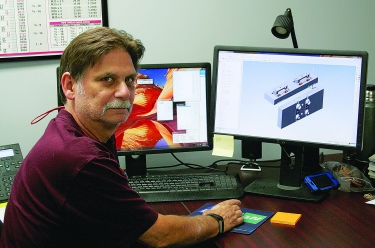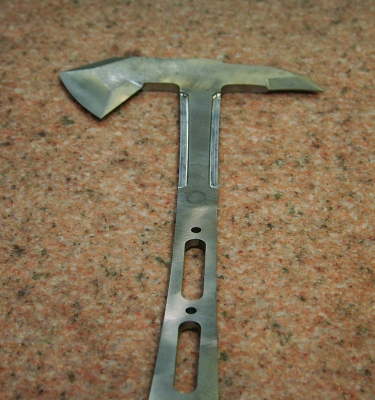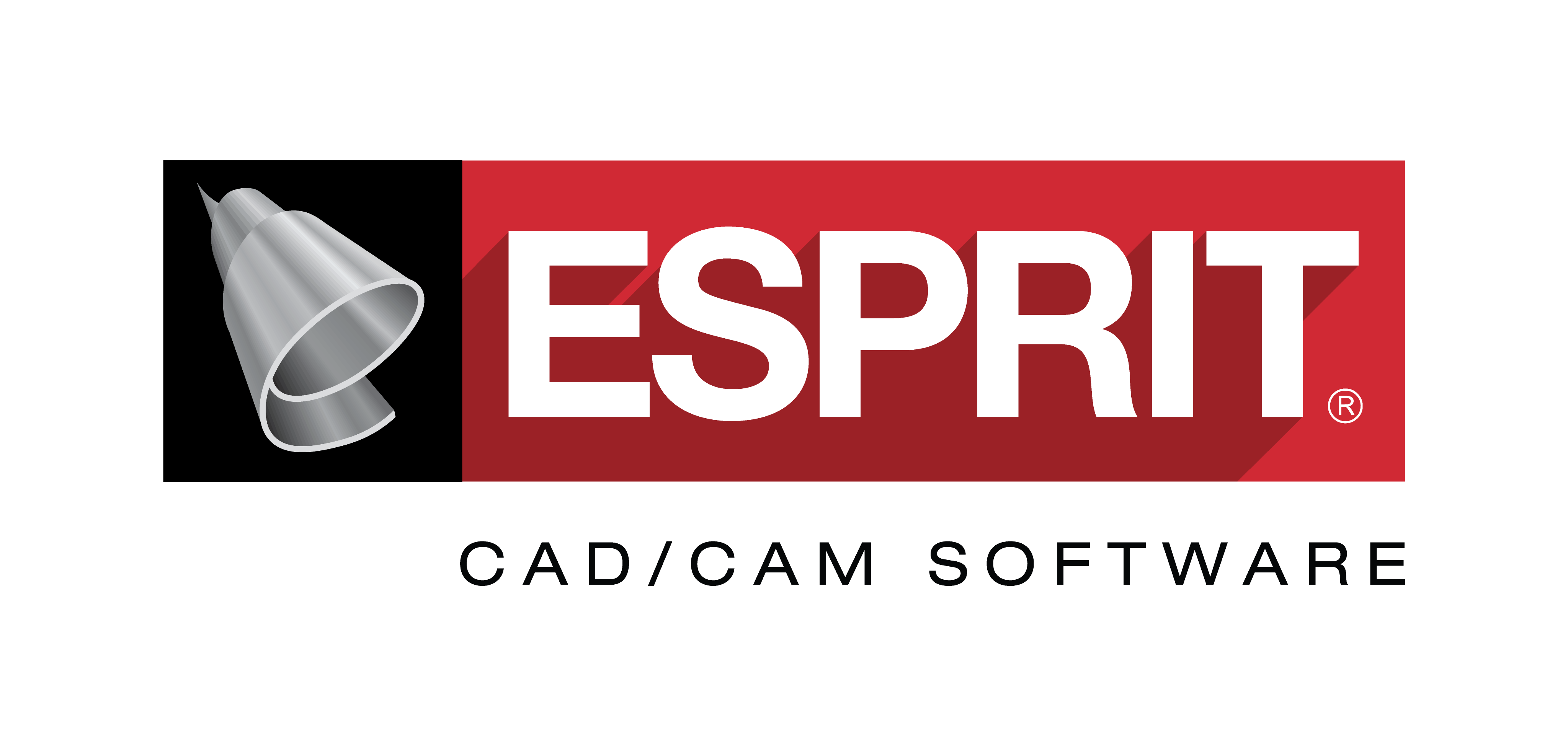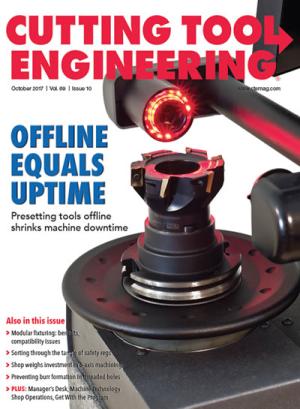End User: DoubleStar Corp., (888) 736-7725, www.star15.com
Solution Provider: DP Technology Corp., (800) 627-8479, www.espritcam.com
Challenge: Write CNC programs to efficiently machine knives.
Solution: 3D milling strategies in a CAM program.
DoubleStar Corp. is well known for the firearms and accessories it manufactures at the company’s 65,000-sq.-ft. facility in Winchester, Ky. DoubleStar’s machine shop houses Haas vertical and horizontal machining centers and drill-tap machines, a Doosan VMC and turning centers, and Tsugami Swiss-style machines.
About 2 years ago, DoubleStar, launched in 1999 by Jack and Teresa Starnes, diversified its product portfolio, adding knives and other edged weapons. They are machined from 1095 steel and S-7 tool steel; the company plans to produce knives made of Nitro-V cutlery-grade steel.
However, machining a knife blade with sculptured surfacing is a more complex job than producing, say, a buttstock for a firearm, according to Tom Vagasky, CNC programmer for DoubleStar. For example, the company’s new Wrath edged weapon has six distinct surfaces, each of which subtly bevels into the next so the surfaces nearly blend together.

Tom Vagasky is CNC programmer at DoubleStar. All images courtesy of DoubleStar.
“That’s not something you could manually program,” Vagasky said.
He added that the aesthetics and smoothness of a blade are critical to the company’s customers. “People who are into this can really see how everything flows together.”
Vagasky was already writing CNC programs with ESPRIT CAM software from DP Technology Corp., Camarillo, Calif., but needed assistance from ESPRIT application engineers when blade production entered the picture. Vagasky said their advice proved quite helpful to get him up and running on the first couple of knives. However, to augment the remote technical support, he visited DP Technology’s office in Rosemont, Ill., to receive personalized training.
“That was a very intense 4 days,” Vagasky said about the training. “I’d been using ESPRIT for almost 7 years, but I was covering stuff I had no clue even existed.”
He added that the training taught him how to program part features directly from a solid model and better understand 3D milling strategies to, for example, extend a surface to obtain the sharp edges of a knife.
Vagasky emphasized that two milling strategies in particular are beneficial for producing knives: between curves and composite. The former enables setting up a free-form shape and then describing it with chains, which bounds the surface to be machined. The latter, which is employed more frequently, allows surfaces to be finely blended together, such as a plunge line extending into another surface.
The programming process begins with the engineering department providing a solid model of the part, which is then imported into the CAM software, Vagasky said. Then he determines how the part should be held and machined.

DoubleStar says its Wrath tomahawk edged weapon, shown without its textured handle, can hack through a car’s A-pillar.
“Once I get everything done, I can go ahead and simulate machining to make sure my surfaces look good and my rotations of the rotary table are good, if I’m using a rotary,” Vagasky said. “I can see all that from the ESPRIT system.”
To exercise greater control over costs and quality, DoubleStar has begun bringing in-house the production of many complex parts that were previously outsourced. “Without ESPRIT, we would not have been able to bring a lot
of these parts under our roof,” Vagasky said.
In addition, the CAM software enables DoubleStar to continually improve its efficiency, according to Vagasky. “When my foreman’s out on the floor and he sees something that needs to be changed to make it better, I can pull it up on the screen and make the change. And boom—we’re running it a better way.”
Contact Details
Related Glossary Terms
- centers
centers
Cone-shaped pins that support a workpiece by one or two ends during machining. The centers fit into holes drilled in the workpiece ends. Centers that turn with the workpiece are called “live” centers; those that do not are called “dead” centers.
- computer numerical control ( CNC)
computer numerical control ( CNC)
Microprocessor-based controller dedicated to a machine tool that permits the creation or modification of parts. Programmed numerical control activates the machine’s servos and spindle drives and controls the various machining operations. See DNC, direct numerical control; NC, numerical control.
- computer-aided manufacturing ( CAM)
computer-aided manufacturing ( CAM)
Use of computers to control machining and manufacturing processes.
- gang cutting ( milling)
gang cutting ( milling)
Machining with several cutters mounted on a single arbor, generally for simultaneous cutting.
- milling
milling
Machining operation in which metal or other material is removed by applying power to a rotating cutter. In vertical milling, the cutting tool is mounted vertically on the spindle. In horizontal milling, the cutting tool is mounted horizontally, either directly on the spindle or on an arbor. Horizontal milling is further broken down into conventional milling, where the cutter rotates opposite the direction of feed, or “up” into the workpiece; and climb milling, where the cutter rotates in the direction of feed, or “down” into the workpiece. Milling operations include plane or surface milling, endmilling, facemilling, angle milling, form milling and profiling.
- solid model
solid model
3-D model created using “building blocks.” This is the most accurate way of representing real-world objects in CAD.
- turning
turning
Workpiece is held in a chuck, mounted on a face plate or secured between centers and rotated while a cutting tool, normally a single-point tool, is fed into it along its periphery or across its end or face. Takes the form of straight turning (cutting along the periphery of the workpiece); taper turning (creating a taper); step turning (turning different-size diameters on the same work); chamfering (beveling an edge or shoulder); facing (cutting on an end); turning threads (usually external but can be internal); roughing (high-volume metal removal); and finishing (final light cuts). Performed on lathes, turning centers, chucking machines, automatic screw machines and similar machines.
End User: DoubleStar Corp., (888) 736-7725, www.star15.com
Solution Provider: DP Technology Corp., (800) 627-8479, www.espritcam.com
Challenge: Write CNC programs to efficiently machine knives.
Solution: 3D milling strategies in a CAM program.



